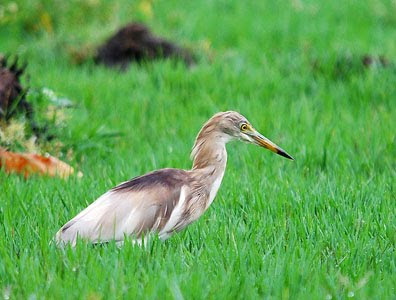It was gloomy and wet as I gradually made my way to the marshlands. The sky really open up and I had to sit the rain out from within the comforts of my car. As the rain started to ease, I spotted this visibly drenched
Brahminy Kite attempting to dry itself on an exposed perch.

Luckily the weather did get better and only then did the birds start off their day - most of them anyway. I guess this Lesser Whistling-duck is feeling really sluggish and lazy after the rain.

Even the usually wary Red-wattled Lapwings did not even bother to scream out their alarm calls as I drove past their territory.

The Common Moorhens, on the other hand, were really up and about. The first thing on today's to-do list is to catch some of the soothing rays of the morning sun.

One particular individual was exceptional tame and this is probably the closest I have ever been to this species.

The rain was intermittent throughout the morning but the White-
browed Crakes seem to be relishing this weather condition. Quite a handful were heard and seen along the edge of the marshlands.


These adorable waterbirds are quite elusive elsewhere and this is probably the best place to observe them in their natural habitat.

Now if only the
Watercock were to perform like the smaller
Crakes...

The Little Grebes are getting prepared for the approaching breeding season and this is usually the best time to photograph them as they will be slightly more confiding than usual.


I don’t see a Little Grebe completely out of the water all that often and a moment like will never be taken for granted.

Most of the Pond-herons I came across this morning were Chinese Pond-herons. In full breeding plumage, the vibrant colour combination of this commoner species outshines those of the other two species that also occurs here in Malaysia.


But a scarcer species will always invoke more excitement – like this
Javan Pond-heron.

Surprising, this sighting is an area lifer for me as I have no previous encounters despite my numerous visits in the past. I decided to go for the sit-and-wait approach and was quite pleased with the outcome.

It did come really close to me at one time but unfortunately, the vegetation prevented me from obtaining an almost perfect shot.

As I was about to wrap things up, a rather creamy-looking Pond-heron immediately caught my attention.
Could it be? It certainly was - my first Indian Pond-heron for the season and another first for this locality as well. Although it was only in partial breeding plumage, the beige neck region and the slightly maroon mantle is enough for me to confirm its identity.











































































